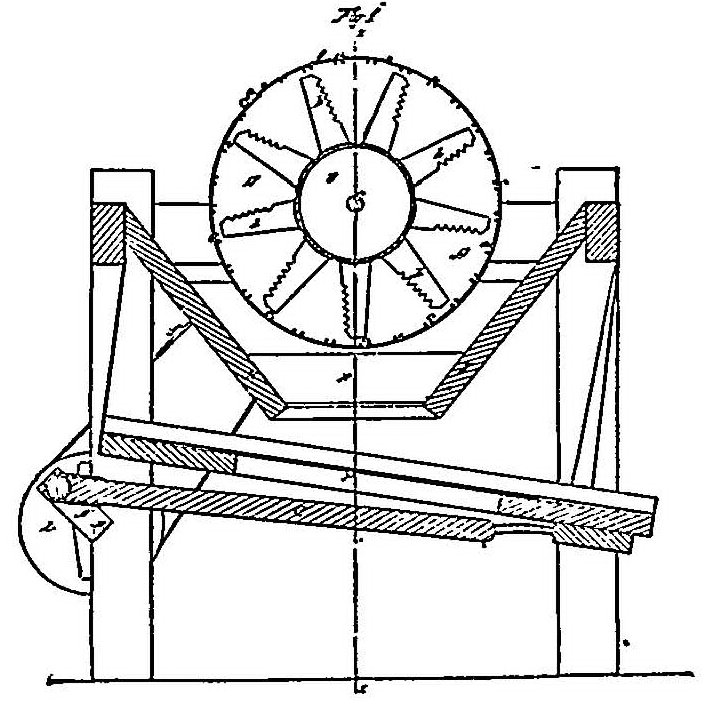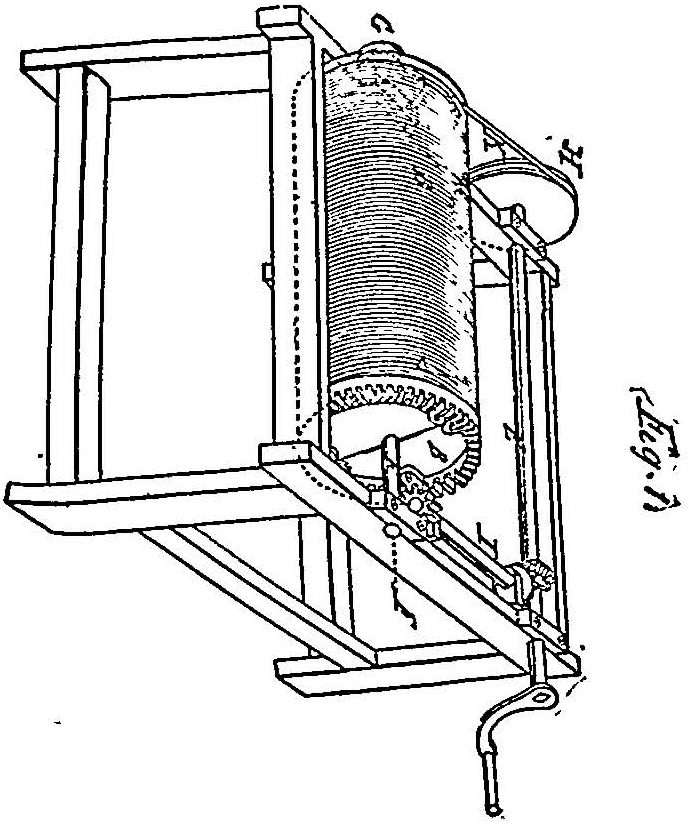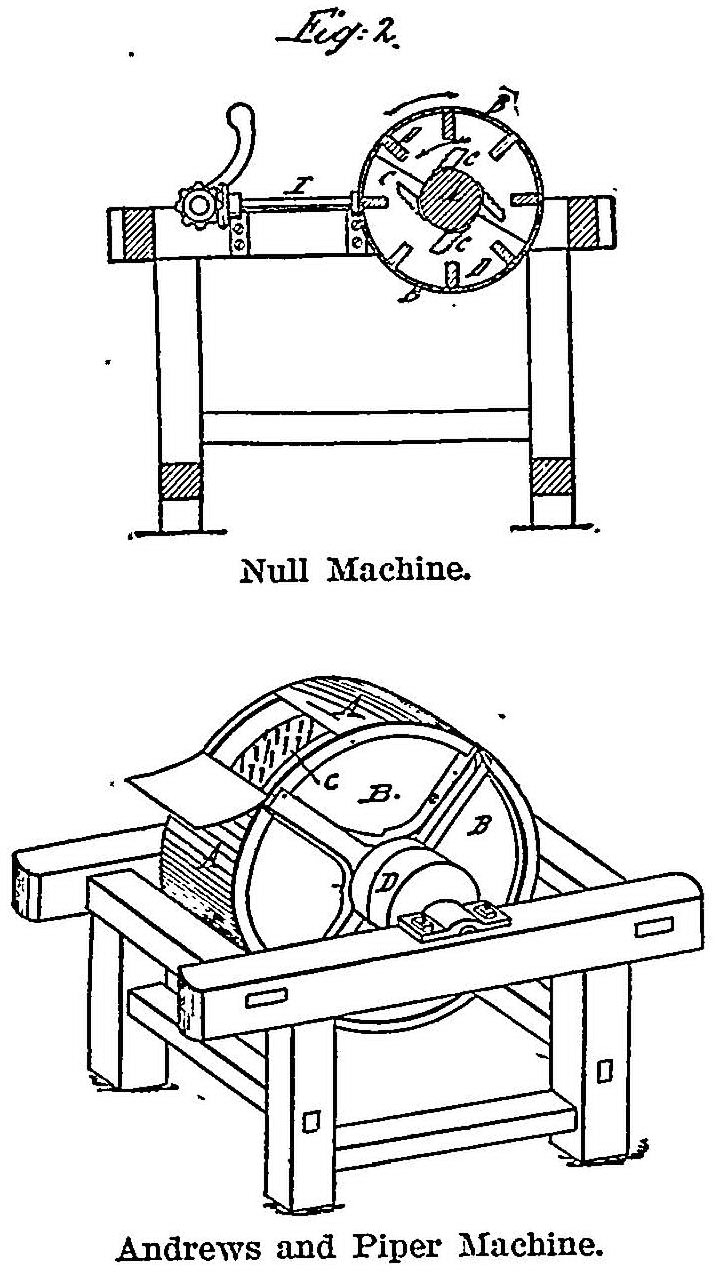
Case No. 3,617.
In re DAVIS.
[1 MacA. Pat, Cas. 628.]
Circuit Court, District of Columbia.
April Term, 1859.
PATENTS—REJECTION OF CLAIMS—WANT OF PAK-TICULARITY.
[A claim is properly rejected when it does not set forth particularly and specifically the points of novelty relied on to distinguish the machine from prior ones, but merely claims the whole combination, with the manner of operating it.]
[This was an appeal by William Davis from a decision of the commissioner of patents refusing to grant him a patent for an improvement in hominy machines.
[In his specifications the appellant describes his invention as follows:]
“Fig. 1, being a vertical section of a hominy machine, constructed and arranged in my improved manner,” etc. “I employ two revolving cylinders, A and B, which are mounted in a suitable frame, and are constructed, arranged and operated in relation to each other, and for the purpose, substantially as herein specified. The outer cylinder, A, is hollow and receives the corn to be made into hominy, in batches introduced through a door, D, or in any other convenient manner. The periphery of this cylinder is perforated with numerous holes, or apertures, a, a, &c, on all sides. These apertures are usually punched from the outside, through the sheetiron of which the cylinder is generally made, and thus furnish burrs on the inner surface to assist somewhat in the process of removing the hulls from the corn; but this mode of punching is not essential. The apertures are all of uniform size, and such as to allow the pieces of hominy to pass through them and escape from the cylinder, as soon as reduced to the desired size,—generally to half or quarter grains. This feature is important, essential to the proper working of the machine, and is the only feature claimed as new, in the construction of the outer cylinder. It serves both the ordinary purpose of allowing the hulls to escape, and of discharging the hominy as fast as reduced to the desired degree of fineness, thereby attaining the double desideratum of preventing the reduction of the grains below the proper size, and to irregular sizes, and also of not impeding by their presence the action of the beaters of the inner cylinder, in reducing the remaining, unbroken grains. The cylinder is provided with a pulley, E, or its equivalent, whereby a slowly revolving motion is imparted to it, in either direction, so as to discharge the hulls and hominy as fast as produced, through the apertures, a, a, &c, and to continually present different grains to the action of the beaters of the inner cylinder.

“The inner cylinder, B, is much smaller in diameter than the outer cylinder, say, of about one third of the diameter thereof. Its length is nearly the same, but such as to allow it to be located within said outer cylinder, concentric therewith. Its shaft, C, extends outward through the hollow journals, d, d, of the outer cylinder; and on one end of said shaft are seemed two pulleys, G, H, or their equivalents, through which rapid, revolving motion is communicated to the cylinder from any suitable motive power. These pulleys have diameters nearly in the ratio of 3 to 5, one to the other, so that, by connecting one or the other with the motive power, moving at a uniform velocity, the same ratio of speeds may be produced on the cylinder, B, for the purpose hereinafter set forth. It is obvious that any other means by which the said relative speed of the cylinder may be produced, would be the equivalent of this arrangement of pulleys. And small variations of the speed required, may be obtained by varying the speed of the motive power, in any convenient way. Serrated or other equivalent sharpened or roughened arms, b, b, &c, project radially from the cylinder, B, on all sides, nearly but not quite to the inner surface of the outer cylinder, A, substantially as represented. The cylinder, B, is driven in the proper direction to cause the serrated edges (if only one edge of each arm is serrated, or roughened) to precede, and act on the corn.
“The cylinders being thus constructed and arranged, their operation is to be substantially as follows: A batch of com is put into the outer cylinder,—as much as can be conveniently worked at one time, or any amount less than that quantity. The two cylinders, A and B, are then set in motion, the former turning quite Slowly, but not requiring any determinate speed; but the cylinder, B, is first driven at about the speed of 300 revolutions a minute, by running the driving band over the larger pulley, G. This velocity may vary somewhat, according to the size of the machine, and to the kind and condition of the corn, say within the limits of 250 revolutions and 350 revolutions a minute. But I believe 300 revolutions a minute to be about the best average speed; and the proper speed is always readily determined by observing whether the hulls pass freely out without being mixed with broken pieces of corn. If the hulls do not come out plentifully, (as they should in a minute or so,) the speed is to be increased till such an effect is obtained; but if broken grains, in any considerable number, come out with the hulls, the motion is too rapid and should be diminished, till only hulls appear. Thus the operator has always an unerring guide to the proper velocity. As soon as the hulls are removed, which process is usually terminated in about 10 or 12 minutes, and is indicated by the hulls ceasing to escape from the apertures of the outer cylinders, the band is shifted to the smaller pulley, H, and a speed of about 500 revolutions a minute is communicated to the inner cylinder, B, or say within the limits of 430 and 550 revolutions a minute, according to various sizes of machines, or to the kind and condition of corn. This velocity quickly breaks the corn into hominy, which immediately escapes through the apertures, a, a, &c, as fast as reduced to the determinate size, leaving the remainder unimpeded thereby. The proper speed is indicated by the escape of hominy. If it escapes continually and rapidly, the proper speed is attained; if not, the speed is to be increased; a greater speed than sufficient for the purpose wastes power, and also wastes the corn by beating it into fine particles. This part of the process is continued till the whole batch is reduced to hominy.
“The above change and determination of velocities given to the inner cylinder, in connection with the gauging apertures of the outer cylinder, as described, are absolutely essential to the manufacture of good hominy, for these reasons: The hulls cannot be completely removed, except before the grains are broken, since the broken pieces are too light to offer sufficient resistance for the purpose. Hence a proper speed to remove the hulls must precede the breaking of the grains, which only can be accomplished by a subsequent increase of speed. And the gauging apertures are necessary, so as to discharge the hominy as fast as reduced to the determinate size; for if it remains longer in the machine, it must necessarily be broken to fine pieces. Hominy, to cook well and evenly, should be of uniform size; and this has heretofore only been attained by screening the irregularly broken grains into different grades of sizes; whereas, by this machine, no such screening is necessary. Other revolving machines merely remove the hulls, and that imperfectly. They leave most of the grains unbroken,—what are broken are imperfectly hulled.”
[The claim reads as follows:] “The hulling and breaking cylinder, B, provided with the serrated arms, b, b, or their equivalent, and driven at the different speeds, as herein specified, in combination with the containing cylinder, A, constructed and operating substantially as described.”
[This claim was rejected upon a reference to the patents of S. Null, No. 8,972, of May 25, 1852, and the patent to Andrews and Piper, No. 1,894, of December 10, 1840.
[The Null machine, like that of the applicant, has two cylinders, one within the other, which revolve in opposite directions. A wire gauze covers the outer cylinder, having meshes sufficiently large to let the hulls through, but not the broken corn. The inner cylinder has serrated beater arms, and revolves faster than the outer one, but the two are so geared together that their relative speed cannot be changed.
55

[The Andrews and Piper patent is for a barley huller. It also has two concentric cylinders, but they revolve in the same direction,—the outer faster than the inner one.
[The report of the board of examiners on appeal was adopted by the commissioner as his decision. It is as follows:]
“Commissioner's decision: The main feature of the alleged invention consists in accelerating the speed of the hulling or breaking wheel after the machine has been in operation a short time. This change of speed is claimed in connection with certain peculiarities of construction, &c. The applicant does not, however, limit himself to any particular mode of changing the speed of the breaking wheel, nor does he undertake to fix or define the speed at which the breaking wheel should be run when of any particular size, but leaves the whole matter to be determined by experiments and practical trials on the part of the operator. As it regards the machine used by the applicant, we do not perceive that it differs materially from those to which reference has been made, and consequently, so far as we can discover, it presents no point of novelty on which to base a patent. Great stress, however, is laid on the fact that the speed of the breaking wheel is to be changed during the process of hulling, &c, and that by such change of speed great and important results are produced. This may be true; but, when viewed in this light, it must be regarded in the nature of a process, and as such (no particular machinery or speed of machinery being relied on) it ought to have been claimed. We do not wish, however, to be understood as expressing an opinion favorable to the renewing of the application in a different form, since we entertain very great doubt whether even a very limited claim to the process could be allowed in view of the cases cited. If, however, the case should be presented in this light, an examination might disclose the fact that the same thing has been done by various other persons, and that, too, long prior to the alleged invention and discovery thereof by the applicant. It may also be observed in this connection that a claim to accelerating the speed of the hulling or breaking wheel was refused to the applicant on an appeal to the commissioner in 1856. The claim in the present application seems to differ from the one then refused, in this: In the 1856 application the claim seems to be based on the [change of speed alone, while in the present application the change of speed is claimed in connection with certain alleged peculiarities of construction, &c. The model is the same one, however, which was furnished in the former application. Now, whether the change of the claim be regarded as merely an attempt to avoid the force of the commissioner's decision in the 1856 application or not, is immaterial, since we do not find anything in the machine on which to base or allow a patent; and we must therefore recommend that this application be finally rejected.”
Reasons of appeal: That the commissioner of patents is in error, in that he declares that the inventor does not “undertake to fix or define the speed at which the breaking wheel should be run when of any particular size, but leaves the whole matter to be determined by experiments and practical trials on the part of the operator.” Second. That the
56commissioner of patents has failed to com prehend the nature of the invention, wherein he says: “As it regards the machine used by the applicant,” he does “not perceive that it differs materially from those to which reference has been made, and consequently,” so far as he can discover, “it presents no point of novelty on which to base a patent;” and therefore erred in rejecting the application from such imperfect knowledge and comprehension of the invention. Third. That the commissioner of patents erred in his conclusion from the statement in the specification concerning the importance of the change of speed given to the breaking cylinder during the act of making hominy; that “this may be true, but, when viewed in this light, it must be regarded in the nature of a process, and as such (no particular machinery or speed of machinery being relied on) it ought to have been claimed.” Fourth. That the commissioner of patents is in error, in that he does “not find anything in the machine on which to base or allow a patent”
MERRICK, Circuit Judge. The applicant having in his specification described the improved machine in all its parts and the manner in which it should be operated, defines his claim of novelty as follows: “What I claim as my invention, and desire to secure by letters-patent is the hulling and breaking cylinder, B, provided with the serrated arms, b, b, or their equivalents, and driven at the different speeds, as herein specified, in combination with the containing cylinder, A, constructed and operating substantially as described.” The patent law makes especial requisition for clearness and definiteness of claim in the specifications for machines, by declaring that the applicant shall fully explain the principle and the several modes in which he has contemplated the application of that principle or character by which it may be distinguished from other inventions, and shall particularly specify and point out the part, improvement, or combination which he claims as his own invention or discovery. It would be difficult with this rule prescribed by the statute, to conclude, from reading the specification and claim of the applicant in this case, that the only points of novelty asserted by him for his improved machine are the adjustment of the size of the holes of the outer cylinder so as to permit the due escape of the hominy, when in the progress of the operation the grains of corn are successively broken to the requisite size, and the change, by means of the requisite adjustment of parts of the machinery, of the velocity of movement of his cylinder from one certain rate of revolution to another certain rate of revolution, at proper stages in the process of manufacture. These points of novelty are not set forth and claimed particularly and specifically as the matter of his discovery, but his claim is for the whole combination of the machinery and manner of operating it at different degrees of velocity. The claim is therefore too broad, and was properly rejected by the office as disclosing no novelty upon the references given to Null's machine and the barley-hauling machine of Andrews and Piper. Considering, therefore, that the second reason of appeal cannot be sustained, in view of the references given, and that the first and third do not present proper matter of inquiry upon a specification framed in such general terms, and not making claim of novelty for that upon which these supposed errors are assigned, and the fourth reason being identical with the second, I am of opinion, and accordingly certify to the Hon. S. F. Shugert, commissioner of patents, that there is no error in the decision of the office upon the claim in the shape in which it is now submitted. Whether it may be so amended as to present patentable novelty, is a question upon which I cannot pass judgment upon the present appeal; and I further, therefore, certify that the judgment of the commissioner is affirmed, and the application for a patent must be denied.
[NOTE. After the rendition of the foregoing opinion, Davis filed a new application, and on May 24, 1859, patent No. 24,104 was granted to him, with the following claim: “What I claim as my invention, and desire to secure by letters-patent, is providing the outer cylinder, A, with apertures, a, a, gauged to such a size as, while serving to discharge the hulls, also to perform the additional function of discharging the hominy as soon as reduced to the desired degree of fineness, in combination with the inner cylinder, B, when the same is driven at the specific speeds, as herein described, for the purposes specified.”]
This volume of American Law was transcribed for use on the Internet
Google.
